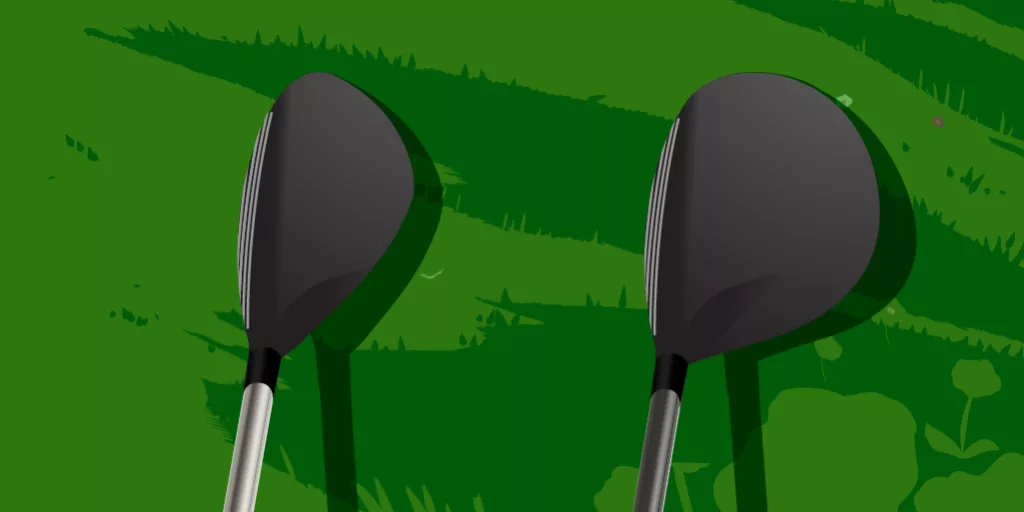
The debate between choosing hybrids and fairway woods is common among golfers. Selecting the proper club for various situations on the course can significantly impact a golfer's game.
Key Takeaways
- Hybrids are easier to hit, while fairway woods offer more distance
- Club choice depends on skill, preference, and course conditions
- Customize your club mix for optimal performance
Getting to Know Hybrids
Overview of Hybrids
Hybrids are golf clubs combining the features of fairway woods and irons. They are designed to provide an alternative option for players who struggle with long irons and are looking for a more forgiving club.
Design and Characteristics of Hybrids
Hybrids have a smaller clubhead than fairway woods but larger than traditional irons. They usually feature a lower center of gravity and a deeper face, making them easier to hit from various lies. Hybrids also offer a higher trajectory than long irons, which can help clear obstacles and stop the ball on the green.
Ideal Scenarios for Using a Hybrid
Long approach shots from the fairway when a high trajectory and soft landing are required.Recovery shots from the rough when a traditional iron might be challenging to hit.Off the tee on tight par 4s and par 3s when accuracy and control are more important than distance.
Understanding Fairway Woods
Overview of Fairway Woods
Fairway woods are versatile golf clubs designed for use off the tee, in the fairway, and even in light rough. They are typically used for longer shots that require a higher trajectory and greater distance.
Design and Characteristics of Fairway Woods
Fairway woods have a larger clubhead than hybrids and irons, which helps generate more power and a higher launch. They generally feature a shallower face and lower center of gravity, making hitting the ball off the ground easier.
Ideal Scenarios for Using a Fairway Wood
- Off the tee on long par 4s and par 5s when accuracy is more important than distance.
- Long approach shots from the fairway when trying to reach the green in fewer strokes.
- Recovery shots from the light rough when there is ample room to land the ball safely on the green.
Comparing Hybrid and Fairway Woods
Distance Capabilities
Fairway woods generally offer greater distance than hybrids due to their larger clubhead and higher clubface speed. However, hybrids are easier to control and may provide a more consistent distance for many players.
Versatility and Ease of Use
Hybrids are often considered more versatile than fairway woods, as they can be used in a broader range of situations. They are generally easier to hit from various lies and offer a higher trajectory, which can be beneficial for clearing obstacles and stopping the ball on the green.
Forgiveness and Consistency
Hybrids are typically more forgiving than long irons and can be more consistent than fairway woods for some golfers. This forgiveness can improve accuracy and fewer mishits, which may help lower scores.
| Fairway Woods | Hybrids | |
|---|---|---|
| Clubhead Size | Larger | Smaller (compared to fairway woods) |
| Distance | Greater distance | Less distance (compared to fairway woods) |
| Versatility | Less versatile | More versatile |
| Ease of Use | May be more challenging for some players | Easier to hit from various lies |
| Trajectory | Lower trajectory | Higher trajectory |
| Forgiveness | Less forgiving (compared to hybrids) | More forgiving |
Choosing the Right Club: Factors to Consider
Golfer's skill level and swing speed
When deciding between fairway woods and hybrids, consider your skill level and swing speed. Generally, fairway woods are more challenging to hit consistently, making hybrids a better choice for beginners or those with slower swing speeds.
Course conditions and course layout
The course conditions and layout can play a significant role in your club choice. For example, if the course has tight fairways and small greens, you may find that hybrids provide more accuracy and control. On the other hand, if the course is more open, a fairway wood can help maximize distance off the tee.
Individual preference and comfort level
Ultimately, the best club for you will depend on your individual preference and comfort level. Try out fairway woods and hybrids to determine which suits your playing style and gives you the most confidence on the course.
Balancing Fairway Woods and Hybrids in Your Golf Bag
Determining the optimal club mix
When building your club set, balancing fairway woods and hybrids is essential. This balance should reflect your skill level, typical course conditions, and personal preferences.
Customizing club selection based on personal requirements
As your golf game evolves, your club selection may change as well. Don't be afraid to experiment with different club combinations to find the best fit for your current skill level and playing style.
Adapting club choices as skills and preferences evolve
As you progress in your golf journey, your skills and preferences will likely change. Be open to adapting your club selection to match your evolving game, ensuring you have the best tools for optimal performance on the course.
Conclusion
In summary, both hybrids and fairway woods have unique advantages and characteristics. Fairway woods are known for their distance and power, while hybrids offer versatility, forgiveness, and ease of use. When selecting the right club for your game, carefully evaluate your skill level, playing style, and course conditions, keeping in mind that personal preferences and comfort levels play a significant role in your decision. By taking the time to understand the differences between fairway woods and hybrids, you can make an informed choice that will ultimately help you improve your golf game and enjoy the sport even more.
Frequently Asked Questions
Answers to frequently asked questions about fairway woods vs hybrids.